Giochi dell'Oca e di percorso
(by Luigi Ciompi & Adrian Seville)
(by Luigi Ciompi & Adrian Seville)

|
Giochi dell'Oca e di percorso
(by Luigi Ciompi & Adrian Seville) |

|
 |

Torna alla ricerca giochi (back to game search) |
 |
| New (The) Game of Human Life | ||
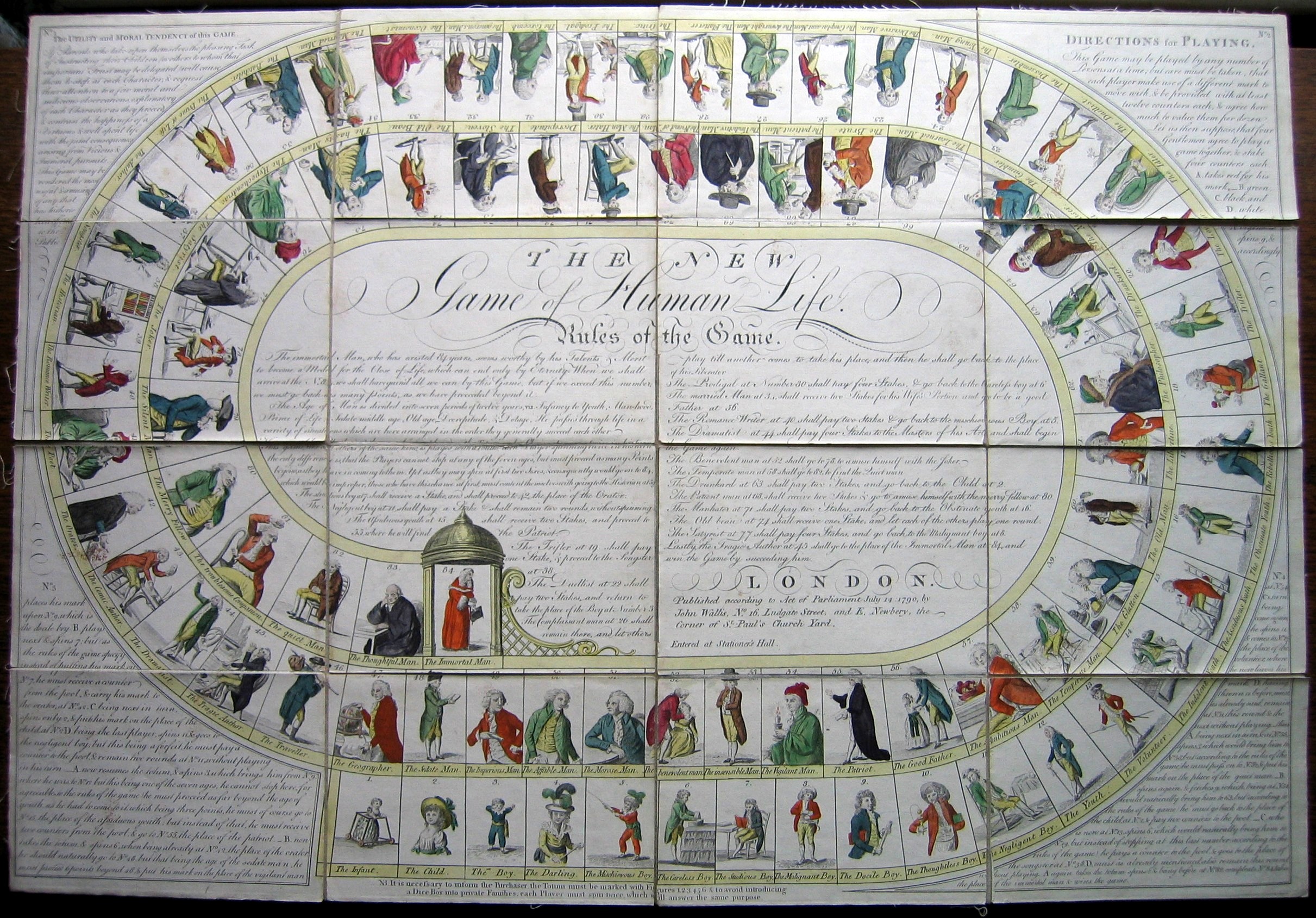 |
Versione stampabile
 |
Invia una segnalazione

|
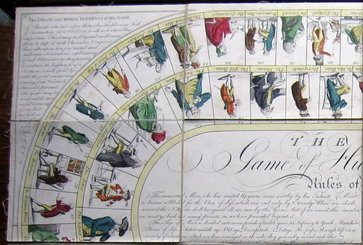 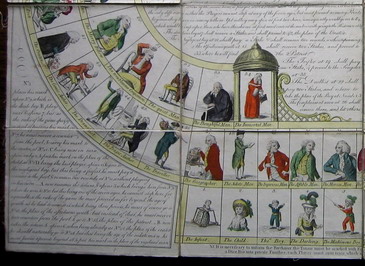 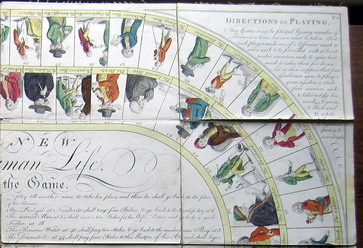 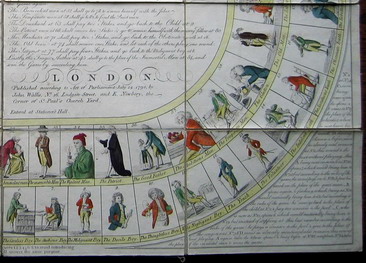 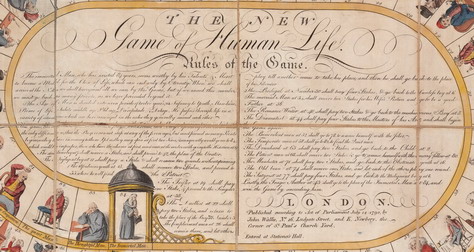 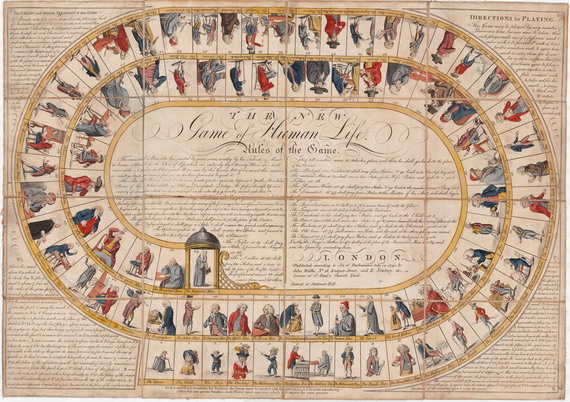 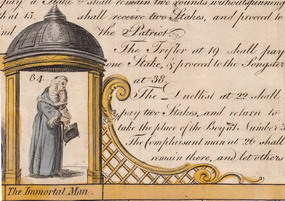 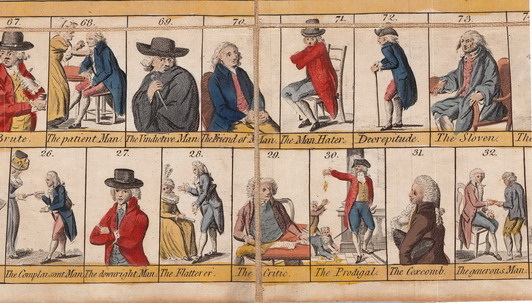 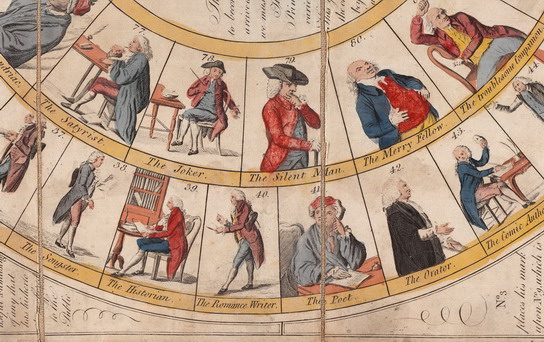 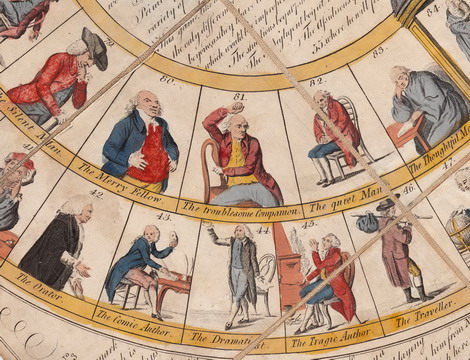 |
primo autore: | Non indicato |
| secondo autore: | Wallis John-Newbery E. | |
| anno: | 1790 | |
| luogo: |
Inghilterra-Londra |
|
| periodo: | XVIII secolo (4°/4) | |
| percorso: | Percorso di 84 caselle numerate | |
| materiale: | carta incollata su tela (engraving on paper with linen backing) | |
| dimensioni: | 467X682 | |
| stampa: | Litografia (gravure) (engraving) | |
| luogo acquisto: | Germania | |
| data acquisto: | 20-04-2019 | |
| dimensioni confezione: | ||
| numero caselle: | 84 | |
| categoria: | Vita umana, attualità, lavoro e tempo libero | |
| tipo di gioco: | Gioco di percorso | |
| editore: | Published july 14 1790 by John Wallis n°16 Ludgate Street and E. Newbery the Corner of S.t Paul's | |
| stampatore: | John Wallis n°16 Ludgate Street and E. Newbery the Corner of S.t Paul's Church Yard | |
| proprietario: | Collezione A. Seville - L. Ciompi | |
| autore delle foto: | A. Seville - L. Ciompi | |
| numero di catalogo: | 144 | |
| descrizione: |
Gioco di 84 caselle numerate, spirale, antiorario, centripeto. Il "Nuovo Gioco della Vita Umana" è una versione del Gioco dell'Oca estesa a 84 caselle in modo da rappresentare le sette età dell'uomo ciascuna costituita da 12 anni. Le caselle dell'età (12, 24 ecc.) fungono da caselle con l'Oca e raddoppiano il punteggio. A farlo considerare un gioco moralista sono i vari imprevisti; per esempio il Prodigo, alla casella 30, deve pagare quattro gettoni e fare ritorno alla casella 6, il Ragazzo Noncurante. Ovviamente il primo è raffigurato mentre spreca il proprio denaro, il secondo mentre costruisce una casa di carte, chiaro esempio di uno sforzo inutile. Gli editori furono Elizabeth Newbery e John Wallis; la prima era uno dei maggiori editori di materiali per ragazzi e fu probabilmente lei l'autrice della rivendicazione sull'utilità e tendenza morale di questo gioco. Questo è una copia di una versione pubblicata da Crepy a Parigi quindici anni prima ma con alcuni cambiamenti effettuati per adeguarlo al mercato inglese. La figura nella casella della vittoria rappresenta Sir Isaac Newton al posto di Voltaire della versione francese. Una rozza caricatura del Principe Reggente Giorgio appare alla casella 57, dedicata all'Uomo Ambizioso, mentre il Capitano Cook, l'esploratore, è rappresentato con il suo globo alla casella 47, il Geografo. REGOLE: al centro. CASELLE: con didascalia. REFERENZA 1 "The New Game of Human Life" (V&A Museum). This game is subtitled Being the Most Agreeable and Rational Recreation Ever Invented for Youth of Both Sexes. It is played as a journey through life from year 1 to 84. The Age of Man is divided into 7 periods of 12 years: Infancy to Youth, Manhood, Prime of Life, Sedate Middle Age, Old Age, Decrepitude and Dotage. Players use a teetotum, an early form of dice, to progress through life. Along the way they encounter a variety of typical situations. The manufacturer describes the advantages of this game thus: 'If parents who take upon themselves the pleasing task of instructing their children (or others to whom that important trust may be delegated) will cause them to stop at each character and request their attention to a few moral and judicious observations, explanatory of each character as they proceed and contrast the happiness of a virtuous and well spent life with the fatal consequences arising from vicious and immoral pursuits, this game may be rendered the most useful and amusing of any that has hitherto been offered to the public'. Physical description Design: hand coloured engraving with the rules engraved in the centre flattened spiral of 84 compartments with the design in an anti-clockwise pattern; 16 sheets of paper mounted on linen Equipment required: teetotum; marker per player; at least 12 counters per player with an agree value per dozen; slip case of marbled paper with engraved label on the front. N°of squares: 84 Squares illustrated: 84 Square numbering: each is numbered 1-84 Squares titled: all Subject of starting square: The Infant Subject of ending square: The Immortal Man Place of Origin: London Date: 14/07/1790 Artist/maker: Newberry, Elizabeth; Wallis, John Materials and Techniques: Hand-coloured engraving Marks and inscriptions: J. Wallis and E. Newbery, Corner of St. Paul's Church Yard on playing surface Dimensions: Height: 47 cm; width: 68.5 cm. (Case): height: 7; width: 5 in Object history note: subtitle: With Rules for Playing Being the Most Agreeable and Rational Recreation Ever Invented for Youth of Both Sexes Historical context note Rewards: receipt stakes and /or moves forward, according to the rules Forfeits: payment of stakes (counters) and/or moving backwards or staying an extra turn in one spot; in accordance to the rules N°of Players: any Rules: RULES OF THE GAME (engraved in the centre of the playing surface) The Immortal Man, who has existed 84 years, seems worthy of his Talents and Merit to become for the Close of Life, which can end only by Eternity. When we shall arrive at the N°84, we shall have gain'd all we can by this Game, but if we exceed this number, we must go back as many points as we have proceeded beyond it. The Age of Man is divided into seven periods of 12 years, viz. Infancy to Youth, Manhood, Prime of Life, Sedate Middle Age, Old Age, Decrepitude and Dotage. He passes through life in a variety of situations which are arrange in the order they generally succeed each other. This game like all others of the same kind is played with a totum, each Player spinning twice in his turn, the only difference is, that the Players cannot stop at any one of the seven ages, but must proceed as many points beyond, as they have in coming to them. Yet as they may spin at the first 2 sixes and consequently would go onto 84, which would be most improper, those who have this chance at first, must content them selves with going to the Historian at 39. The Studious Boy at 7 shall receive a Stake and shall proceed to 42, the place of the Orator. The Negligent Boy at 11 shall pay a Stake and shall remain two rounds without spinning. The Assiduous Youth at 15 shall receive 2 Stakes, and proceed to 55, where he will find the Patriot. The Triflet at 19 shall pay 1 Stake, and proceed to the Songster at 38. The Duellist at 22 shall pay 2 Stakes, and return to take the place of the Boy at Number 3. The Complaisant Man at 26 shall remain there, and let others play until another comes to take his place, and then he shall go back to the place of his liberator. The Prodigal at Number 30 shall pay four Stakes, and go back to the Careless Boy at Number 6. The Married Man at 34 shall receive two Stakes for his Wife's Portion and go to be a Good Father at 56. The Romance Writer at 40 shall pay 2 Stakes and go back to the Mischievous Boy at 5. The Dramatist at 44 shall pay 4 Stars to the Masters of his Art and shall begin the game again. The Benevolent Man at 52 shall go to 78 to amuse himself with the Joker. The Temperate Man at 58 shall go to 82, to find the Quiet Man. The Drunkard at 63 shall pay 2 Stakes and go back to the Child at 2. The Patient Man at 68 shall receive 2 Stakes and go to amuse himself with the merry fellow at 80. The Manhater at 71 shall pay 2 Stakes and go back to the Obstinate Youth at 16. The Old Beau at 74 shall receive 1 Stake and let each of the others play one round. The Satyrist at 77 shall pay 4 Stakes and go back to the Malignant Boy at 8. Lastly the Tragic Author at 45 shall go to the place of the Immortal Man at 84 and win the Game by Succeeding him. DIRECTIONS AND EXPLANATIONS (engraved in the spandrels) 1. The Utility and Moral Tendency of this Games. If parents who take upon themselves the pleasing task of instructing their children (or others to whom that important trust may be delegated) will cause them to stop at each character and request their attention to a few moral and judicious observations, explanatory of each character as they proceed and contrast the happiness of a virtuous and well spent life with the fatal consequences arising from vicious and immoral pursuits, this game may be rendered the most useful and amusing of any that has hitherto been offered to the public. 2. Directions for Playing This game may be played by any number of persons at a time; but care must be taken, that each player makes use of a different mark to move with, and be provided with at least twelve counters each, and agree how much to value them per dozen. Let us then suppose that four gentlemen agree to play a game together, and stake four counters each. A takes red for his mark, B green, C black and D white. A begins and spins 9 and accordingly places his mark upon No. 9, which is the Docile Boy. B plays next and spins 7, but as the rules of the game specify instead of putting his mark on N°7, he must receive a counter from the pool, and carry his mark to the Orator, at N°42. C being next in turn, spins only 2, and puts his mark on the place of the Child at N°2. D being the last player spins 11, and goes to the Negligent Boy; but this being a forfeit, he must pay a counter to the pool and remain two rounds at N°11 without playing in his turn. A now resumes the totum and spins 3, which brings him from N°9 where he was to N°12, but this being one of the seven ages, he cannot stop there, for agreeable to the rules of the game he must proceed as far beyond the age to N°15, the place of the Assidious Youth; but instead of that he must receive 2 counters from the pool and go to No. 55, the place of the Patriot. B now takes the totum and spins 6, when being already at N°42, the place of the Orator, he should naturally go to N°48 but that being the age of the Sedate Man, he must proceed 6 points beyond 48 and put his mark on the place of the Vigilant Man at N°54. C's turn being but instead of stopping at this last number (according to the rules of the game) he pays a counter into the pool and goes to the place of the Songster at N°38. D must as already mentioned also remain this round without playing. A again takes the totum and spins 2, and being before at N°82 compleats N°84 takes the place of the Immortal Man and wins the game. NB: It is necessary to inform the Purchaser the Totum must be marked with the figures 1-6 and avoid introducing a dice box into private families, each player must spin twice, which will answer the same purpose. The playing sheet is numbered in an anti-clockwise direction starting from the lower left corner. Each compartment shows a boy or a man at ages between 1 and 84. These are: 1. The Infant; 2. The Child; 3. The Boy; 4. The Darling; 5. The Mischievous Boy; 6. The Careless Boy; 7. The Studious Boy; 8. The Malignant Boy; 9. The Docile Boy; 10. The Thoughtless Boy; 11. The Negligent Boy; 12. The Youth; 13. The Volunteer; 14. The Indolent Youth; 15. The Assiduous Youth; 16. The Obstinate Youth; 17. The Rebellious Youth; 18. The Gallant; 19. The Trifler; 20. The Lover; 21. The Idler; 22. The Duellist; 23. The Dissembler; 24. The Young Man; 25. The Decisive Man; 26. The Complaisant Man; 27. The Downright Man; 28. The Flatterer; 29. The Critic; 30. The Prodigal; 31. The Coxcomb; 32. The Generous Man; 33. The Economist; 34. The Married Man; 35. The Batchelor; 36. The Prime of Life; 37. The Author; 38. The Composer; 39. The Historian; 40. The Romance Writer; 41. The Poet; 42. The Orator; 43. The Comic Author; 44. The Dramatist; 45. The Tragic Author; 46. The Traveller; 47. The Geographer; 48. The Sedate Man; 49. The Imperious Man; 50. The Affable Man; 51. The Morose Man; 52. The Benevolent Man; 53. The Insensible Man; 54. The Vigilant Man; 55. The Patriot; 56. The Good Father; 57. The Ambitious Man; 58. The Temperate Man; 59. The Glutton; 60. The Old Man; 61. The Libertine; 62. The Philosopher; 63. The Drunkard; 64. The Miser; 65. The Gambler; 66. The Learned Man; 67. The Brute; 68. The Patient Man; 69. The Vindictive Man; 70. The Friend of Man; 71. The Man Hater; 72. Decrepitude; 73. The Sloven; 74. The Old Beau; 75. The Hasty Man; 76. The Hypochondriac; 77. The Satyrist; 78. The Joker; 79. The Silent Man; 80. The Merry Fellow; 81. The Troublesome Companion; 82. The Quiet Man; 83. The Thoughtful Man; 84. The Immortal Man. Rules placement: in centre of playing sheet Descriptive line: Hand coloured moral race game, The New Game of Human Life, published in England by J. Wallis and E. Newbery in 1790. REFERENZA 2 WHITEHOUSE, Francis Reginald Beaman, (pag. 46-47): THE GAME OF HUMAN LIFE, London. Published according to Act of Parliament, July 14, 1790 by John Wallis, No 16 Ludgate Street and E. Newbery, the corner of St. Paul’s Church Yard. Entered at Stationers Hall. An engraving size 27 in X 18 ¾ in, hand-coloured, mounted in 16 sections on linen contained in slip-in case with oval label on one side printed “The New Game of Human Life with Rules for Playing: being the most Agreeable & Rational Recreation ever Invented for Youth of both Sexes". (Author’s copy has a further ticket affixed reading “From the TOY & TUNBRIDGE WARE Repository, 64, High Holborn”). The moral character of the game is strongly developed; it states: "N.B. It is necessary to inform the Purchaser, the Totum must be marked with the figures 1, 2, 3, 4, 5, 6 to avoid introducing a Dice Box into private Families.” The game takes the form of a race commencing at No 1 "The Infant", and in an anti-clockwise manner continues until 84 "The Immortal Man". Under the "Utility & Moral Tendency of the Game”- which occupies the left-hand corner- The Happiness of a Virtuous and Well Spent Life is contrasted with the fatal consequences arising from Vicious and Immoral Pursuits, and it is stated that the game “May be the most useful of any that have hitherto been offered to the Public”. Note by Author: Unless many other games then published have failed to survive to the present day, these remarks would appear to apply to Goose and Geographical Map Games. Each panel of the game represents a year of life. The age of man is divided into 7 periods of 12 years each: 1) Infancy to Youth 1-12, 2) Manhood 13-24, 3) Prime of Life 25-36, 4) Sedate Middle Age 37-48, 5) Old Age 49-60, 6) Decrepitude 61-72, 7) Dotage 73-84. Conditions of life and opinions have changed from when a century and a half ago, manhood commenced at 13 years and old age at 49! REFERENZA 3 "Bien qu'il montre les époques de la vie de l'homme, divisée en sept périodes de douze ans, "The New Game of Human Life" (Le Nouveau Jeu de la Vie Humaine) n'est pas résérvé aux garçons comme le révéle le titre: "..Récréation la plus agréable et raisonnable jamais inventée pour la jeunesse des deux sexes". Sous la rubrique "utilité et tendance morale de ce jeu", le parents sont pressés d'instruire leurs enfants sur chacun des personnages avec "quelques observations morales et judicieuses...opposant le bonheur d'une vie vertueuse et bien remplie avec les fatales conséquences d'occupations vicieuses et immorales". La plupart des noms des personnages ont aujourd'hui la meme signification, meme si certaines punitions ne paraissent plus nécessaires de nos jours, notamment celles concernant les auteurs. Le romancier doit payer deux jetons et retourner à la case 5 de l'enfant espiègle, tandis que l'auteur dramatique doit en payer quatre et recommencer le jeu. L'auteur tragique a sans doute la pénalité la plus sévère, car il va de la case 45 à la case 84, celle de l'Homme Immortel, et il meurt; par ce deplacement toutefois, le joueur gagne en fait le jeu et la cagnotte. Le "Nouveau jeu de la vie humaine" gravure peinte à la main, a été publié par John Wallis et Elizabeth Newbery le 14 juin 1790." (GOODFELLOW Caroline) REFERENZA 4 "Although it shows the Ages of Man, divided into seven periods of 12 years, "The New Game of Human Life" was not restricted to boys alone as the title reveals: "...most Agreeable and Rational Recreation ever Invented for Youth of Both Sexes". Under the heading "Utility and Moral Tendency of this Game" the parents are urged to instruct their children on each of the charactere with "a few moral and judicious observations...and contrast the happiness of a virtuous and well-spent life with the fatal consequences arising from vicious and immoral pursuits". Most of the names of the characters have the same meanings today, although some of the punishments accorded would not be considered necessary today notably those for the authors. The Romance Writer must pay two stakes and return to the Mischievous Boy at 5, while the Dramatist must pay four and begin the game again. The Tragic Author has possibly the harshest penalty, for he goes from 45 to 84, the Immortal Man, and dies; by this move, however, the player actually wins the game and the kitty. "The New Game of Human Life" a hand-coloured engraving, was published by John Wallis and Elizabeth Newbery on july 14th 1790"." (GOODFELLOW Caroline) REFERENZA 5 "British Museum"© The Trustees of the British Museum. 1893, 0331.125 Title: "The New Game of Human Life". Materials: paper. Techniques: hand-coloured, etching. Production person: Published by John Wallis&Elisabeth Newbery. Production place: Published in London. Date: 14 Juli 1790. Schools /Styles: British. Description: Game-board with 84 pictorial compartments each depicting a stage in life or a arranged in a spiral, each representing the character of a man at a particular age, from 1 to 84. The rules in the centre and the corners. Hand-coloured etching, cut into 12 sections and pasted onto a cloth backing. Inscription Content: At bottom, to right, in centre "Published according to Act of Parliament July 14 1790 by/ John Wallis N°16, Ludgate Street, and E. Newbery, the/ Corner of St. Paul's Church Yard/ Entered at Stationer's Hall" Dimensions: Height: 467 millimetres; width: 682 millimetres REFERENZA 6 The New Game of Human Life - Das neue Spiel vom Leben des Menschen London, 1790 Kupferstich, handkoloriert, 47X68 cm Verlag: John Wallis, Elizabeth Newbery, London "Rational Recreation" verspricht The New Game of Human Lje im Untertitel, und zwar fuer die "Jugend beiderlei Geschlechts". Einander gegenuebergestellt werden "das Glueck eines tugendhaften und sinnvollen Lebens und die schrecklichen Folgen boesartigen und unmoralischen Verhaltens". Das menschliche Leben - hier ganz eindeutig: das Leben des Mannes - wird in sieben Abschnitte zu je zwoelf Feldern (Jahren) geteilt: Es reicht von Kindheit und Jugend bis zum gesetzten Mannesalter und schliesslich, im Schlussfeld, zum Eintritt in die Unsterblichkeit. Dazwischen werden lohnenswerte und weniger lohnenswerte gesellschaftliche Rollen vorgestellt. Studiert man die Charaktere genau, so die Spielanleitung selbstbewusst, "dann kann sich dieses Spiel als das nuetzlichste und unterhaltsamste von allen erweisen, die bis dato der Oeffentlichkeit praesentiert wurden". Dem Spiel beigefuegt ist statt zweier Wuerfel ein "Teetotum", ein Kreisel mit sechs Segmenten, das die Wuerfel ersetzt, "to avoid introducing a dice box into private families". Das Prinzip des Zufalls im Spiel konnte offenbar akzeptiert werden, das Aggregat, das den Zufall produziert, war in der Stube des guten Buergers allerdings unerwuenscht und musste durch den unverdaechtigen Kreisel ersetzt werden. Das Spiel ist die englische Uebertragung oder Kopie des franzoesischen Le Nouveau Jeu de Ia vie Humaine, das 1775 in Paris erschien, und das mit nur minimalen Variationen Bild fuer Bild abgezeichnet, koloriert und ins Englische uebersetzt wurde. Einige als Personen erkennbare Charaktere wurden veraendert, am deutlichsten wohl im Schlussfeld, wo Isaac Newton den Franzosen Voltaire ersetzt (vgl. linke und rechte Abbildung). Interessant ist die Einstellung zu den Kuensten und Kuenstlern - fast alle werden bestraft. Am haertesten trifft es den Satiriker: Er muss vier Einsaetze zahlen und von Feld 77 auf 8 zurueck. Dem Autor von Romanzen (40) und dem Dramatiker (44) geht es kaum besser, belohnt wird einzig der Tragoede im Spiel des Lebens: Er darf von Feld 45 nach 84 aufsteigen und in die Unsterblichkeit einruecken. Vielleicht eine kleine ironische Pointe des Spiels? Spielregeln Dieses Spiel kann von einer beliebigen Anzahl von Personen gespielt werden; aber es muss drauf geachtet werden, dass jeder Spieler ein unterschiedliches Zeichen zum Vorruecken verwendet und jeder mit mindestens zwoelf Spielmarken ausgestattet ist und dass bestimmt wird, wie viel dieses Dutzend wert ist. (Anm.: Es wurde also wie fast immer um reale Einsaetze bzw. Geld gespielt). Der unsterbliche Mann, der 84 Jahre gelebt hat (Feld 84), scheint durch seine Talente und Leistung wuerdig, ein lnbegriff fuer den Abschluss des Lebens zu werden, das nur durch die Ewigkeit enden kann. Wenn wir bei der 84 ankommen, haben wir alles in dem Spiel erreicht; aber wenn wir diese Zahl ueberschreiten, muessen wir so viele Punkte zurueckgehen, wie wir vorher gewuerfelt haben. Das Alter des Menschen ist in sieben Perioden von jeweils 12 Jahren geteilt: Saeuglingsalter, Jugend, Erwachsenenalter, Bluete des Lebens, ruhigeres mittleres Alter, hohes Alter und Klapprigkeit. Der Spieler durchlaeuft das Leben in einer Vielzahl von Situationen, die hier in der Reihenfolge, wie sie in der Regel aufeinanderfolgen, angeordnet sind. Auf den Altersfeldern (12, 24 etc) kann er die Augenzahl seines Wurfes verdoppeln und geht weiter. Eine Ausnahme gibt es dabei: Wirft ein Spieler zwei Sechser am Anfang, so koennte er durch Verdoppelungen bis 84 kommen, was unangemessen waere; diejenigen, welche die Moeglichkeit haben, muessen sich damit zufriedengeben, zum Historiker auf 39 zu gehen. Der lernbegierige Bub auf 7 soll einen Einsatz bekommen und soll weiter zu 42 gehen, dem Platz des Redners. Der laessige Bub auf 11 soll einen Einsatz zahlen und zwei Runden aussetzen. Die gewissenhafte Jugend auf 15 soll zwei Einsaetze bekommen und geht zu 55, wo sie den Patrioten finden wird. Der Duellant auf 22 muss zwei Einsaetze zahlen und kehrt zurueck, um den Platz des Buben auf 3 einzunehmen. Der entgegenkommende Mann auf 26 soll dort bleiben und andere spielen lassen, bis ein anderer kommt, um seinen Platz einzunehmen, dann soll er zurueck auf den Platz seines Befreiers kehren. Der verschwenderische Mann auf Feld 30 soll vier Einsaetze bezahlen und geht zum leichtsinnigen Jungen auf 6 zurueck. Der verheiratete Mann auf 34 soll zwei Einsaetze von der Mitgift seiner Frau bekommen und wird ein guter Vater auf 56. Der Autor von Romanzen auf 40 soll zwei Einsaetze zahlen und kehrt zum Lausbuben auf 5 zurueck. Der Buebnenautor auf 44 soll vier Einsaetze an die Meister seiner Kunst zahlen und soll das Spiel erneut beginnen. Der gebieterische Mann auf 49 muss einen Einsatz zahlen und weiter zum Saenger auf 38 gehen. Der wohlwollende Mann auf 52 soll zu 78 gehen, um sich mit dem Schalk zu vergnuegen. Der gemaessigte Mann auf 58 soll zur 82 gehen, um den stillen Mann zu finden. Der Trunkenbold auf 63 soll zwei Einsaetze zahlen und geht zum Kind auf 2 zurueck. Der geduldige Mann auf 68 soll zwei Einsaetze erhalten und geht sich mit dem lustigen Kerl auf 80 vergnuegen. Der Menschenhasser auf 71 soll zwei Einsaetze zahlen und geht zur gewissenhaften Jugend aui 16 zurueck. Der alte Galan auf 74 soll einen Einsatz erhalten und die anderen eine Runde spielen lassen. Der Satiriker auf 77 soll vier Einsaetze zahlen und geht zum boesartigen Buben auf 8 zurueck. Zuletzt soll der Tragoedienautor auf 45 zur Stelle des unsterblichen Menschen auf 84 gehen und seine Nachfolge antreten. Die Rollen (Felder) im Leben 1 Der Saeugling 2 Das Kind 3 Der Bub 4 Der Liebling 5 Der Lausbub 6 Der leichtsinnige Bub 7 Der lernbegierige Bub 8 Der boesartige Bub 9 Der sanftmuetige Bub 10 Der gedankenlose Bub 11 Der laessige Bub 12 Die Jugend 13 Der Freiwillige 14 Die traege Jugend 15 Die gewissenhafte Jugend 16 Die hartnaeckige Jugend 17 Die rebellische Jugend 18 Der Kavalier 19 Der Muessiggaenger/ Weiberheld 20 Der Liebhaber 21 Der Faulenzer 22 Der Duellant 23 Der Heuchler 24 Der junge Mann 25 Der spoettische Mann 26 Der entgegenkommende Mann 27 Der ehrliche Mann 28 Der Schmeichler 29 Der Kritiker 30 Der verschwenderische Mann 31 Der Geck 22 Der grosszuegige Mann 33 Der Okonom 24 Der verheiratete Mann 35 Der Juriggeselle 36 Die Bluete des Lebens 37 Der Autor 38 Der Saenger 39 Der Historiker 40 Der Autor von Romanzen 41 Der Dichter 42 Der Redner 43 Der Lustspielautor 44 Der Buehnenautor 45 Der Tragoedienautor 46 Der Reisende 47 Der Geograf 48 Der gesetzte Mann 49 Der gebieterische Mann 50 Der freundliche Mann 51 Der griesgraemige Mann 52 Der wohlwollende Mann 53 Der gefuehllose Mann 54 Der wachsame Mann 55 Der Patriot 56 Der gute Vater 57 Der ehrgeizige Mann 58 Der gemaessigte Mann 59 Der Vielfrass 60 Der alte Mann 61Der Freidenker/Casanova 62 Der Philosoph 63 Der Trunkenbold 64 Der Geizhals 65 Der Spieler 66 Der gelehrte Mann 67 Der Rohling 68 Der geduldige Mann 69 Der rachsuechtige Mann 70 Der Menschenfreund 71 Der Menschenhasser 72 Der Altersschwache 73 Der Schmutzfirik 74 Der alte Galan 75 Der voreilige Mensch 76 Der Hypochonder 77 Der Satiriker 78 Der Schalk 79 Der schweigsame Mann 80 Der lustige Kerl 81 Der schwierige Gefaehrte 82 Der stille Mann 83 Der nachdenkliche Mann 84 Der unsterbliche Mensch. Literatur - Henry-René D’AlIemagne: Le noble jeu de l’oie en France, de 1640 à 1950, Paris 1950, S. 74 f. - Adrian Seville, John Spear: The Game of the Goose in England - a Tradition lost. In: The Ephemerist (151/2010) (Ernst Strouhal) REFERENZA 7 Game 68: The New Game of Human Life The New Game of Human Life. London: John Wallis, No. 16 Ludgate Street and E[lizabeth] Newbery, the corner of St. Paul’s Churchyard, 1790. Copper engraving with original hand color, 47 x 68 cm., dissected and laid on linen in 4 x 4 panels. Refs.: Ciompi/Seville 0144; Whitehouse pl. E and pp. 46–47. This game of 84 spaces is one of the most well known of English Georgian board games. Much less well known is that it derives from a French game, "Le Nouveau Jeu de la Vie Humaine", which pre-dates it by 15 years. The English version is a close copy of the French original, reproducing the design and detailed layout, though all the images have been redrawn. This is indeed a game of human life: the track shows the various stages of life, beginning with The Infant, and continues by showing the qualities and kinds of temperament, leading to different career outcomes. The game is a Goose variant, but the favorable doubling spaces are spaced by 12 in a single series to give the seven ages of man, beginning with Infancy, then: Youth (12), Manhood (24), Prime of Life (36), Sedate Middle Age (48), Old Age (60), and Decrepitude (72). There is a special rule for the initial throw of double six (corresponding to the Goose rule for the initial throw of nine), pointing out that to double the throw forward to the end would “not be reasonable” and that the thrower must be content to move only to the Historian at space 39. The hazards do not correspond to those in Goose but have their own rationale. Among these: The Studious Boy at space 7 goes on to become the Orator at space 42; the Complaisant Man at space 26 must stay until another takes his place; the Prodigal at space 30 must pay and go back to space 6, the Careless Boy; the Married Man at space 34 receives 2 as “Wife’s portion” and goes on to space 56, the Good Father; the Romance Writer at space 40 must pay for time wasted and go back to space 5, the Mischievous Boy; the death penalty is reserved for the Dramatist at space 44, who must pay ”to the Masters of his Art” and start the game again. Finally, the Tragic Author at space 45 goes on to become the Immortal Man, and wins the game by succeeding him. The Immortal Man of the French version is Voltaire, leaning on a stick in characteristic pose; he died at the age of 84, corresponding to the length of the track. When the game was copied for Wallis and Newbery in 1790, several of the characters were changed to represent well-known Englishmen such as Alexander Pope (the Poet, space 41), Captain Cook (shown with a globe as the Geographer at space 47), William Pitt (the Patriot, space 55), the Prince Regent (at space 57, in a crude caricature to represent the Ambitious Man), and Isaac Newton (the Immortal Man at space 84), maybe since it was thought that an atheist was unsuitable for a British audience. Newton, like Voltaire, died at the age of 84. At the bottom of the sheet is a note: “It is necessary to inform the Purchaser the Totum must be marked with the figures 1 2 3 4 5 6 & to avoid introducing a dice box into private families, each player must spin twice, which will answer the same purpose.” Elizabeth Newbery (1746 - 1821) was the leading juvenile publisher of the period and perhaps suggested this addition, as well as the note at the top left on ”The Utility and Moral Tendency of this Game.” (Adrian Seville) Exhibitions: - "The Royal Game of the Goose four hundred years of printed Board Games". Exhibition at the Grolier Club, February 23 - May 14, 2016 (Prof. Adrian Seville). - "Instruction and Delight: Children's Games from the Ellen and Arthur Liman Collection". Exhibition at the Yale Center for British Art, 17 January -23 May, 2019). |
|
| bibliografia: |
1) WHITEHAUSE, F.R.B.: "Table Games of Georgian and Victorian Days", London, Peter Garnett, 1951. 2) GOODFELLOW, Caroline: "A Collector's Guide to Games and Puzzles". Secaucus, New Jersey, Chartwell Books-London, Quintet Publishing Limited 1991. 3) GOODFELLOW, Caroline: "The Development of the English Board Game, 1770-1850", in Board Games Studies 1, 1998. 4) GOODFELLOW, Caroline: "Jeux de société. Le guide du collectionneur des jeux de société depuis le XVIIIe siècle jusqu’à nos jours", (Edizione francese) Carrousel MS, 2001. 5) SEVILLE, Adrian: "The Game of Goose: and its influence on cartographical race games" Journal of the International Map Collectors' Society, Winter 2008 N°115 2008. 6) SEVILLE, Adrian: "The geographical Jeux de l'Oie of Europe." In "Belgeo" 2008 3-4 2008. 7) GOODFELLOW, Caroline: "How We Played: Games From Childhood Past", History Press, 2012. 8) QUINN, Brian - CARTWRIGHT, William: "Geographic Board Games". Geospatial Science Research 3. School of Mathematical and Geospatial Science, RMIT University, Australia. December 2014. 9) SEVILLE, Adrian: "The Royal Game of the Goose four hundred years of printed Board Games". Catalogue of an Exhibition at the Grolier Club, February 23 - May 14, 2016. 10) LIMAN, Ellen: "Georgian and Victorian Board Games: The Liman Collection", Pointed Leaf Press, 2017. 11) NORCIA, Megan A.: "Gaming Empire in Children's British Board Games, 1836-1860". Studies in Childhood, 1700 to the Present. Routledge, 2019. |
|
| "The Development of the English Board Game, 1770-1850" (Caroline G. Goodfellow) | ||
| Games of Moral Improvement. "Table Games of Georgian and Victorian Days". (Francis Reginald Beaman, Whitehause) | ||
Vai alla ricerca giochi Vai all'elenco autori